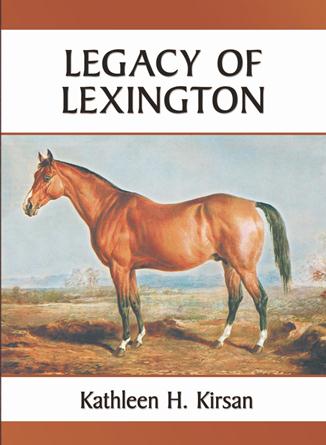Real Stayers
Four-Mile Heat Racers of Yesteryear
There was a time in England and the Colonies (America) when racehorses were being bred that had such immense quantities of both stamina and speed that they were regularly raced four miles several times in a meet. These four-mile heat racers of yesteryear were the real stayers. What we breed today and call stamina-bred is just a shadow of the athleticism that these amazing creatures possessed. Let this article serve as a brief outline of the story of the greatest racehorse breed the world has ever seen.
For the full story of these real stayers, the racing and sport dynasties they spawned, and the fantastic results in our day when critical mass is created in their lines see Legacy of Lexington. You will discover wherever there is excellence in sport that the sterling lines forged in the 1800s were the height of sport performance and are behind our best sport horses, both racers and non-racing sport performers.
These stayers arose from our original racehorse breed the American Running Horse which was raced in our first heat races for almost a hundred years (both at the pace and the gallop...they could do both) before a Thoroughbred raced in a heat race here in the colonies. Later after 1818 when our American Trotter was established as a separate breeding population, it too regularly ran in heat races (see Standardbred Sport Horses) and even in extreme races of 50 and even 100 miles. Stamina is embedded in the foundations of our domestic breeds.
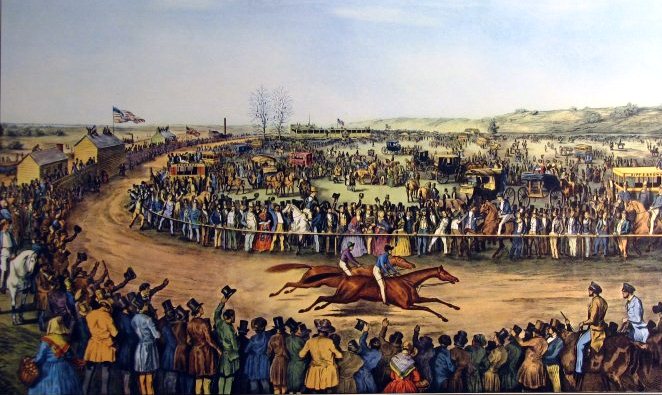
[The famous four-mile heat match race between the Running Horse mares Fashion and Peytona 1846 at Union racecourse, NY]
In England, before the Thoroughbred was a breed, King Charles II decreed that formal racing with heats was to be carried out every October at Newmarket Heath. The first race was run in 1666 in England. This was the beginning of the performance standards that would create the world's most successful racehorse breed: the Thoroughbred. Racing had been carried on long before this, and the 1500s though 1660 saw the remarkable English Running Horse being bred and competed widely (it was exterminated in both England and Ireland in a political purge led by Cromwell).
It was in the previous reign of King James that the fad developed for crossing in of 'oriental' sires on the English Running Horse to add height and elegance to the shorter cob type Running Horse. Nonetheless, it was what King Charles did in formalizing racing, that is, he set standards with written rules, and this standardized performance test changed everything. The horses who could race successfully were of course chosen as breeding stock over the horses that could not perform.
On the Atlantic seaboard in the American colonies (English) in that same timeframe (1665) Governor Richard Nicolls of the New York Colony also established a two-mile racecourse on Hempstead Plain on Long Island with set performance standards that mimicked those in England; he even named the New York track 'Newmarket' after King Charles' English track. Virginia had formalized 1/4 mile sprints on straight tracks before this, but it was the Long Island track that was keeping step with the new English racing form. This style race course started popping up in the other colonies as well, in Virginia in 1677.
While it was traditional to credit the three Turkamen stallions (Byerly, Darley and Godolphin) crossed in with the creation of the Thoroughbred, it is an earlier stallion born in 1670 and named Spanker that some consider the first real English Thoroughbred horse. Spanker was inbred to his dam 2x1, Old Moroccan Mare, a Barb/Hobby cross, and so really, this mare is the foundation of the breed. In America our racehorse breed was the Running Horse, and wrae did not see any English Thoroughbred blood added for its first 100 years, so the American racehorse is not the Thoroughbred, rather our native Running Horse. It was our native Running Horse that ran both sprint and distance races, at both the pace and the gallop. (I have gathered the original historical evidence of this breed, its ancestors, and its descendants in one book.)
America's first racehorse breed was gaited--its intermediate gait was not the trot, but the pace and its variations. It was later with the addition of other breeds into the gene pool--such as the Dutch Cob in New York and later the English part-TB Messenger and his contemporary the foundation sire of the Morgan, Figure RH, that produced the trot mid-gait in our racehorse. What most don't know is that some English Thoroughbreds paced (and trotted) as well in the beginning (see Standardbred Sport Horses for more on this) which is not surprising when we remember that the pre-Thoroughbred racing studs were made up of English Running Horses and Irish Hobbies--gaited race breeds.
Our native Running Horse was carefully bred for racing from imported English Running Horse, Scottish Galloway and Irish Hobby (cousin breeds). These racehorse had been brought in by the wealthiest settlers. These Cavaliers were the racehorse breeders in England (and Ireland) when our colonies were first created. And when they settled here they were set in designing their new place to replicate what they had in the 'old country' (British Isles), they imported the best racehorses in the world and they took great pride in breeding fast horses.
It was in the mid-1700s that we began seeing the first English Thoroughbred imports in America, which coincided with the fad of heat racing waning in England, and this was also the time of our Revolution. Heat racing in England was replaced by the classic length races (one to two-mile races, run once--not heats) then, But, America did not adopt this new British test for another one-hundred years. It was in that same time frame (1760-1860) that the American breeder developed the greatest distance galloping racehorse the world has ever seen, then or now. The world records for four-mile heat racing were all made and broken during that era, culminating in the record set by the Running Horse Lexington in 1855, and then his grandson Fellowcraft.
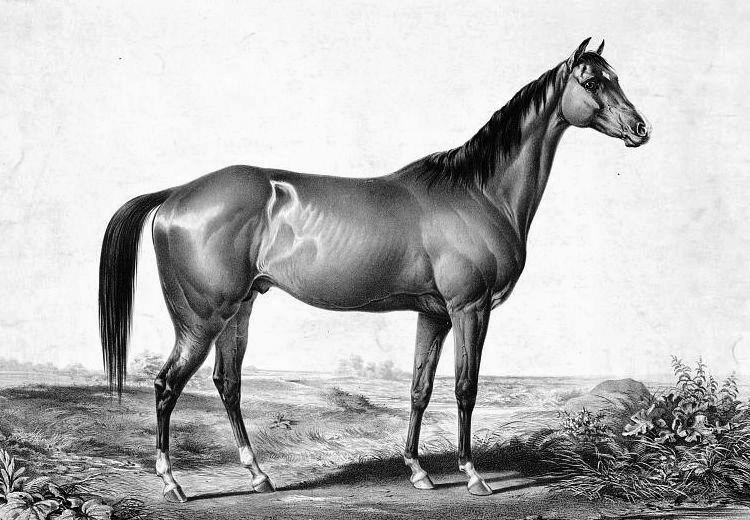
[Lexington RH--the king of stayers--he set a world record for four-mile heat racing and still holds the world record as a stallion--sixteen years leading the list. His world record was beat by his grandson Fellowcraft who improved it by a 1/4 second--a record that still stands.]
As breeders these horses are interesting to us for a number of reasons: one of course is because they are the ultimate stayer, never has there been a faster racehorse for distance then these--nor a stayer that could sustain speed at such humongous distances. If we create 'critical mass' in those super athletic horses of yesteryear we will bring the stamina, speed and soundness to our foals--it is a certainty. (See Tesio Methods for where to find instruction on how to design pedigrees to achieve our goals). Which of us would not want a horse with endless stamina and soundness who could compete into its teens and even twenties?
Four-Mile Heat racers of Renown
Boston RH 1833: Boston is an American Running Horse found in the Racing Hall of Fame. His excellence as both a racehorse and as a sire puts Boston RH in that exclusive company of elite horses such as St. Simon, Man O'War and the more recent Nearco (who carries Boston RH through a Lexington RH daughter on his dam-line). Boston RH was not a Thoroughbred, that breed did not exist yet in America, and he did not have the pedigree requirement of 5 full generations of uncontaminated English stock. After 1750 the breeders of our domestic racehorse often brought in English Thoroughbred bloodlines, most usually an imported English Thoroughbred stallion was bred to the American Running Horse mare, but it would be another one-hundred years before our American Thoroughbred was established as a separate breed. Our Running Horse was our first racehorse breed and has been selectively bred from at least 1624, which is more than one-hundred years before the English Thoroughbred ever made it to this continent.
Did our racehorse breed become Thoroughbred as soon as some English Thoroughbred bloodlines were added? No, of course not! But there is a confusion that occurs from reading the old records, for the term 'thoroughbred' (pronoun--not noun) was used extensively in the 18th and 19th centuries on all species of livestock that had been carefully bred from superior ancestors to improve its qualities. So there were 'thoroughbred' sheep and cattle and hogs as well as horses. Over time the English racehorse became known as 'the Thoroughbred'.
Shortly after the first imports of English typesetters (like Janus) to this country, the English breeding took a different direction. Before this, their racehorse (like ours) ran at 1/4 mile and four-mile heat races (King's Plate), but by the mid-1700s this was changing over to what became known as the classic distance races: one to two-mile, run on a oval track and just once--heat racing was abolished. However, in America we continued on with heat racing of our distance runner through the 1800s (officially abandoned in 1914).
Our galloping strain of Running Horse, especially those bred for distance racing (stayers), made up most of what later became our American Thoroughbred in 1868 when the different racing standards (classic length races) were adopted and specific pedigree qualifications were designated (five generation of GSB registered stock). The setting of separate performance and breeding standards precedes breed formation. Be that as it may, things are more complicated than that. S.D. Bruce's American Stud-Book was the studbook accepted by the American Jockey Club as its official register. Unfortunately, Bruce registered many non-Thoroughbreds in it, actually my calculations show at least 50% maybe as high as 70% are not Thoroughbreds.
Here's the problem, inclusion of non-Thoroughbreds in this register changed their breed label, and has fooled the uninformed ever since. Bruce admitted he could not follow the breed requirement of 5 full generations of GSB registered stock, because he explains to do so would leave out the best American racers and their families. This studbook was one of the major factors in the erasing our native breed from history, because later breeders and historians assumed that anything registered in it was indeed Thoroughbred. The book is a terrible fraud, as was Edgars before it (1833), and it made sure you never understood the history of our American racers (all this is documented in American Running Horse). To give you an idea of how ridiculous this studbook is, you will find Pekina, a American Saddle Horse, registered in it. Pekina never ran a race, she was a gaited saddle horse, and dam to two important sires in the American Saddle Horse breed (precursor breed to the Saddlebred, Tennessee Walker and Missouri Fox Trotter). What is she doing in there? And today you pull her up in online databases you will see her identified as a Thoroughbred!
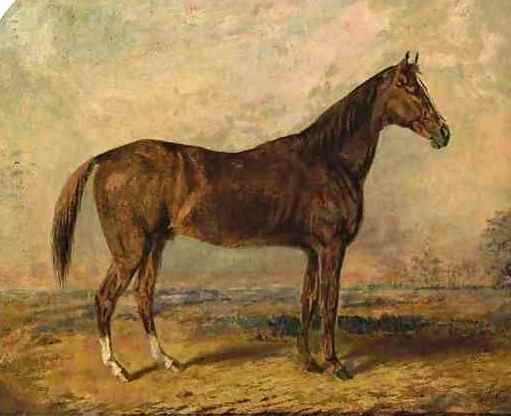
[Boston, the American Running Horse who is considered the best racehorse of the 19th century: forty-one wins of forty-five starts, thirty of those races were four-mile heats.]
Boston RH was an extreme stamina-bred horse, who regularly won at four-mile heat races, these type of races had been run by our Running Horse breed for the two-hundred years from 1665. Boston RH then is an example of the high quality found in our native racehorse breed. He has been rated as the greatest racer of the 19th century. He ran forty-five races and won forty-one of them. Fifteen of those victories were consecutive, thirty were four-mile heat races and nine were three-mile heat races. He was undefeated at age four and five, and lost only once at six, and that to the Running Horse mare Fashion, who set a world record for four-miles in that race (Fashion RH will be our other example--discussed below).
To get an idea of what this record means, realize you must win 2 heats to win the contest. Heats equals 'starts', so in comparison to our racing today, each heat would be a separate stamina race, so we would multiply his heat races by 2 to get a true comparison. Forty-six heat races equals 92 races. We just don't have horses like that today, and when we find one that is even close to that ability we are completely amazed. Back then it was normal.
He began partial stud duties while he was still racing at eight, and then became a full time stallion at age ten. He stood first in Virginia, then Washington, D.C. and finally in Kentucky. In his last year he sired his two best sons: Lecomte RH and Lexington RH, both world beaters and founders of racing dynasties. He was leading sire 1851, 1852 and 1853, and he was second in 1854. And as was common in that era, he sired a significant amount of trotting racers also. But that is not all, Boston RH and his son Lexington RH are one of the strongest jump lines in the world.
It is interesting that our newly emerged American Trotter (1818--date of first performance standard) was ridden under saddle in heat races also--sometimes in five-mile heats; all our Running Horse derivative breeds possessed speed along with stamina--see Standardbred Sport Horses.
Boston RH was foaled in Virginia in 1833, the same year as the trotting sensations Black Hawk MO and Lady Suffolk AT were born. This era was a remarkable one in American equine history as the strains of our native Running Horse were specializing and would soon become recognized breeds of their own (American Trotter, Morgan, American Saddle Horse and American Thoroughbred).
But at Boston's birth the Morgan, the Trotter and Saddle Horse were just emerging and our Thoroughbred had not become a separate breed of its own yet, which occurred in 1868 with the new Classic race standard (one to two-mile races dash races--not heats) was applied in this country to those horses with enough English Thoroughbred bloodlines (five generations) to qualify.
Once imported--mid-1700s, the English Thoroughbred had been the preferred typesetter for our galloping racehorse for one-hundred years to add height and distance speed to our native Running Horse, or that is what I assumed. I was wrong, further research has revealed the Thoroughbred was never seen in a race in America until 1751 (Morton's Traveler) so the desire to cross them in to our herd was not based on performance. With their newfound affluency, the historical record shows that the Tidewater Virginia breeders as a group decided to convert their Running Horse racing studs to English studs in order to conform to the English way of doing things...it had nothing to do with performance. This was a breeding fad with such a strong preference for 'English' blood that it resulted in a great deal of pedigree 'fudging' and advertisement exaggerations. John H. Wallace cited Boston's 'official' pedigree as one of the casualties of this fraud, especially in the dam lines of both the sire and the dam. Our more recent equine scholar Alexander MacKay-Smith continued investigating Boston's lineage and found more evidence of the true dam-lines. The pedigree you see in here reflects the work they did on this.
One of Boston's dam-lines (Balls Florizel RH) goes straight back to a famous Running Horse mare that is a documented champion sprint racer: Sweet Mary RH. In Edgar's Race and Turf Register she is labeled CQHRM= Celebrated Quarter Horse Race Mare. But in Boston's day and continuing right up through the 20th century no one valued those fast gaited mares, so they hid the ancestry when they could, preferring to think that speed came from the more glamorous thoroughbred and oriental crosses in the imports from England.
Sweet Mary RH was a celebrated sprint racer, so she can stand as an example of what and why our American breeds were so talented. She was a product of the Roanoke Valley breeders who chose to breed sprinters only, and thereby their stock became homozygous for the speed gene--these precious bloodlines were a factor in creating the three greatest racehorse breeds in the world: the Standardbred, American Thoroughbred and the Quarter Horse--all three breeds owe much of their fantastic speed to those breeders long ago who chose to consolidate the speed.
[Note on the sprint studs: Often forgotten is that most of the sprint stud racers were also gaited. This area was where they were specializing in sprint breeding, the Roanoke Valley, not only made the speed gene homozygous but also the gait-keeper gene (read more on those genes in Become Your Own Tesio and Standardbred Sport Horses). Boston RH (and his descendants), who carry these genetics on their dam-lines, was known to produce many fast trotters and jumpers. For a example we can see Halla HE, the greatest Olympic gold medal earner in jumping was 3/4 trotter--her sire was a full Standardbred, and she carried strong line-breeding to Boston RH. Those breeders in the Roanoke Valley, by striving to preserve the original Running Horse type gave us concentrations of speed, jump and gaited traits.]
Mr. Wallace's and Mr. MacKay-Smith's efforts have been vindicated recently with the publishing of various papers on the equine genome that deal with the true ancestry of the Thoroughbred horse. The scientists have discovered that the speed gene in the Thoroughbred comes not from the 'oriental' sires and dams so long believed but from the native English and Irish racehorse mares that made up the broodmare bands of the early English studs. Also it surprised the researchers to discover that it is a sprint speed gene--not distance. They determined that speed originated with those pre-thoroughbred racehorse mares of Running Horse and Irish Hobby blood (native mares). It was horses of that same stock that the Colonial breeders imported for racing and saddle horses, and these have become the genetic base of all our later sport and fine saddle breeds: Quarter Horse, Standardbred, Tennessee Walker, Missouri Fox Trotter, Saddlebred, Morgan and of course American Thoroughbred.
What the science on this gene does not explain is how, if it is only a sprint gene, then how do the greatest distance racers ever bred carry it in such large amounts that when line-bred to they produced the greatest speed lines of modern times. Since this piece was first written an additional genetic discovery was made: there is a separate stamina gene (Dr. Polanski 2018), which explains a lot for me, a horse naturally could carry both genes, as our racing history demonstrates.
The Lexington RH-Boston RH bloodlines possessed such devastating speed combined with stamina that their descendants were sweeping races in Europe as well. This perceived insult to the British racing establishment ultimately resulted in the backlash of the Jersey Act of 1913 through 1949 (see Legacy of Lexington and American Running Horse). There was a monstrous hypocrisy evident with the ban. Not only were the American bloodlines producing racers in France and elsewhere that kept winning, those same lines had left some legacy in England before the ban that were powering their own fastest racers, especially those from the Lady Josephine family (Mumtaz Mahal and Lady Juror) and those descended from Orby. Even the 'sire of the century' Nearco carries Lexington RH as his 4th damsire. And many of the best in France, such as Durbar, Tourbillon and others were descended from these same sources. But it turns out, that was the problem, our bloodlines after demonstrating their racing prowess in England, France and Ireland, became the desired blood for the foreign breeders, rather than the English Thoroughbred, and that was the tipping point, resulting in the banning our the American Thoroughbred from the breed.
The Jersey Act finally came to an end when the financial realities and a general lack of class arising in their own racehorse from its isolated breeding policies, along with French objections to participating in a stud book that bars the best racehorses--all factors in the change in the English Jockey Club's attitude which resulted in them finally (thirty-six years later) modifying their rule so that most of the barred bloodlines were then acceptable.
Fashion RH 1837: As spectacular as Boston's athletic talent was, he was not a 'freak', our native racehorse was producing many racers who came close to his ability and even a few that exceeded him occasionally. Competition raged between different racing areas of the country and match races between regional champions were events of great excitement that drew huge crowds. So it was in May of 1842 that a contest was set up between the southern hero Boston RH against the northern star Fashion RH. Fashion RH was an amazing race mare with a record of thirty-six races, thirty-two wins and four seconds: most of those three and four-mile heat races. She, along with Boston RH, hold a rightful position in the Racing Hall of Fame.
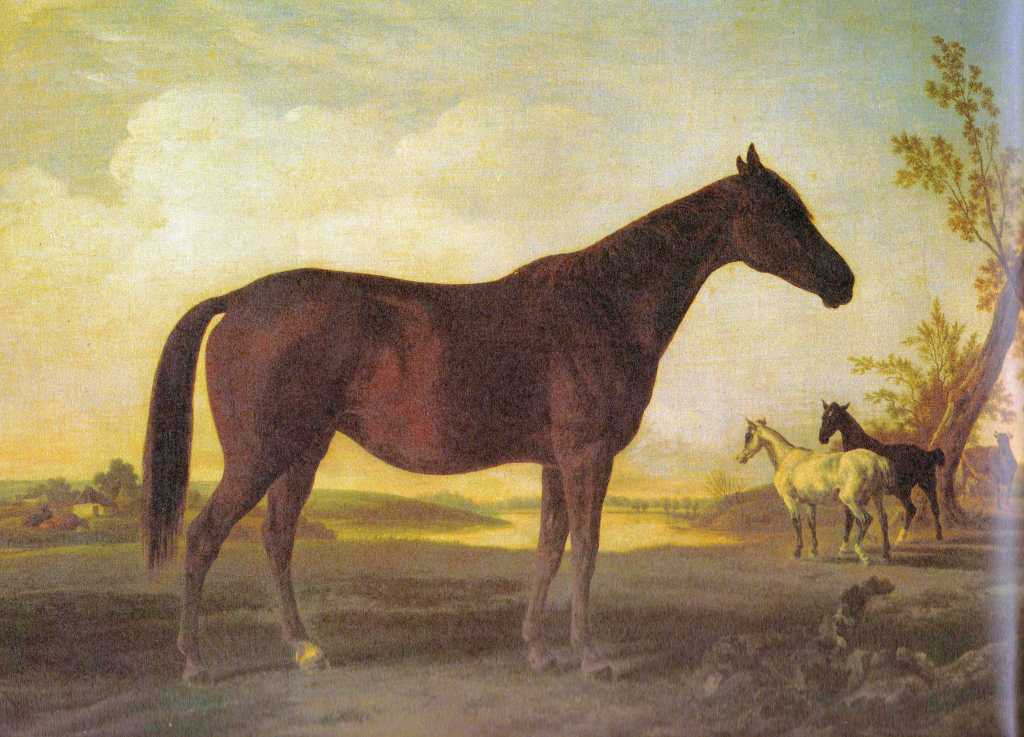
[Fashion, the Running Horse racemare that beat the great Boston RH in 1842]
The race between these two mega-racers was set at Union race course on Long Island, and the then fantastic purse of $20,000, and as each heat was finished carrier pigeons were released to bring the news to the New York newspapers--this was an event!
"The race was in four-mile heats and the contest drew another enormous crowd, estimated at seventy thousand people. The grand stand was crowded with a large array of those distinguished in political, social and sporting life, and for more than a quarter of a mile, on both sides of the course, spectators were packed in solid phalanxes. Intense interest prevailed as the heats were run." (Lyman Weeks)
Four-mile match races were run in heats--the winner being the best two out of three. Fashion RH won the first two heats and therefore the race. Being a mare she was not able to achieve the massive genetic legacy of Boston RH, but she did have seven foals, and her daughter Young Fashion RH proved to be a very good producer as she had ten foals of which six were winners.
Fashion RH herself was beaten by another great racing mare: Peytona TB, who won the match race held in 1846 (illustration at article beginning). Races of this sort were run regularly, the American-bred horses had reached the pinnacle of speed combined with stamina and soundness. It is ironic that today so many of the critics of our Thoroughbred have been trying to convince us that it is a 'sprint-only' breed; it is laughable really, as our breed is based genetically on the best stamina-speed genetics this planet has ever seen.
California Chrome - a modern racer running on the Heroic Era genes
American Thoroughbred---sprint only?
Domestic Sources of Sport Performance
Sound and Durable Thoroughbreds
American Thoroughbred Stamina chef-de-race
